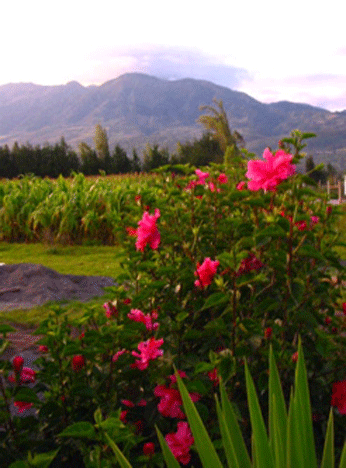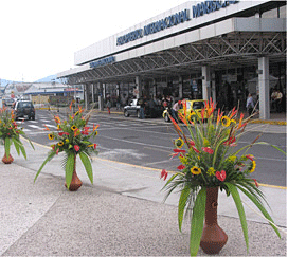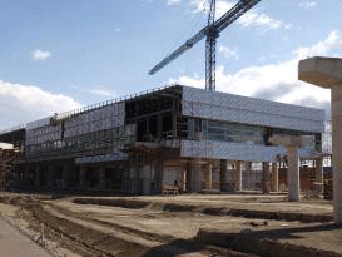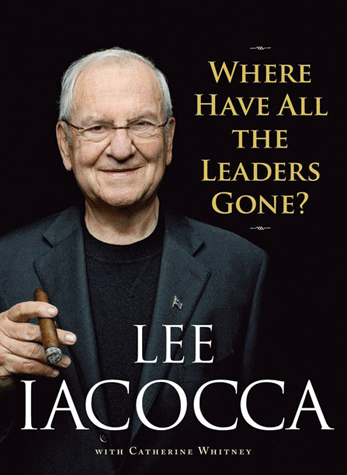Why
Ecuador Flowers
  Cut
flowers are perhaps one of the best examples of how transport costs
and comparative advantages interact to generate valuable export opportunities
for LAC. Cut
flowers are perhaps one of the best examples of how transport costs
and comparative advantages interact to generate valuable export opportunities
for LAC.
Cut flowers fit perfectly with the definition
of time-sensitive goods.
According to some of the most respected
industry estimates, roses, for instance, can last up to 14 days after
harvesting if handled properly.
Assuming a modest retail shelf life expectancy
of seven days, any shipping time that goes beyond seven days (including
both domestic and international transportation) imposes a heavy depreciation
cost to traders.
Proximity is definitely an advantage.
Beyond being time-sensitive, cut flowers
are also labor intensive, given that the harvest cannot be fully mechanized,
and natural resource intensive, since the quality and availability of
land, as well as the characteristics of the climate, are key factors
for the success of the industry.
These characteristics, coupled with recent
development in air transportation and refrigeration, have opened opportunities
for trade, particularly for North-South trade, in a fast growing world
market whose size is estimated between US$40 and US$60 billion annually,
80 percent of which is concentrated in the U.S. (15 percent) and the
EU (65 percent).
The search for land and cheaper labor
to cater for this large and growing demand has been forcing production
to move south to developing countries in Asia, Africa and in LAC.
As proximity would indicate, the U.S.
market has been the focus of the region’s exports. In 2005, approximately
82 percent of U.S. imports of cut flowers originated in the Western
Hemisphere, with Colombia and Ecuador accounting, respectively, for
59 and 18 percent of the total.
The story of Ecuador’s success in
this industry is marked, on the one hand, by a perfect match between
product characteristics and the country’s factor endowments, and
on the other, by a constant effort to overcome the difficulties created
by the country’s precarious infrastructure.
 
Quito the capital of Ecuador
is currently served by the Mariscal Sucre International airport
(left) operated by a joint venture called Corporacion Quiport
SA (Quiport) a partnership of Aecon, Andrade Gutierrez Concessoes
of Brazil, the Airport Development Corporation of Toronto and
HAS Development Corporation of Texas.
The New Quito International Airport
(right) that will replace Mariscal Sucre International Airport
with expanded cargo and reefer operations and free trade zone
and new passenger facilities is being built in Tababela Parish,
about 20 Km east of Quito, Ecuador. Work on the facility began
in 2006 and is expected to be completed by October 2010.
|
The climate (an altitude higher than 2,000
meters above sea level in the equatorial zone), the availability of
rich volcanic soils, low labor costs and the relative proximity to the
U.S. served as a perfect platform for floriculture to develop.
Yet, the shortcomings of Ecuador’s
infrastructure, as well as the failures to acquire the necessary expertise,
meant that the development of the industry was a lengthy and tortuous
process.
Ecuador’s first attempt to export
fresh flowers occurred between 1963 and 1977, but success was limited
given the poor air transportation links to the U.S. market, a lack of
technical know-how, and an absence of related industries.
NOTE 1: The
industry was revitalized in 1983, and in the two decades that followed,
the area of cultivated flowers grew to approximately 5,000 hectares,
60 percent of which was occupied by roses (Expoflores).
NOTE 2: Between
1997 and 2006, exports grew by 12 percent a year from $131 million to
$436 million. Cut flower exports are now the country’s third largest
non-oil source of foreign currency, only behind bananas and shrimp.
NOTE 3: The
bulk of Ecuador’s fresh flower exports goes to the U.S., which
accounts for 58 percent of total sales or 63 percent of the total volume.
Russia is the second most important market, but lags well behind the
U.S.
Apart from endowments and proximity, Ecuador’s
cut flower exports have been benefiting from a preferential access to
the U.S. market (zero tariffs), granted initially by the Andean Trade
Preferences Act (ATPA) ratified in 1991 and later on extended by the
Andean Trade Preferences and Drug Eradication Act (ATPDEA) (2002). The
ATPDEA was supposed to expire in June 2007, but was extended by the
U.S. Congress until December 2008. Before 1991, exports of flowers were
penalized with tariffs ranging from 6.4 to 6.8 percent.
Cut flowers are perishable goods; therefore,
the success and the risks of the industry depend on how well integrated
the different parts of the supply chain are to guarantee a delivery
of a product whose quality is time-sensitive. A full description of
the supply chain of this industry can be found in Vega (2008). The Table
below shows the length of time in different parts of the supply chain
in order to provide the reader with an assessment of where the risk
may be. The table was completed using published information and complemented
by a questionnaire sent to the individuals responsible for operations
at major cargo agencies in Quito. As can be seen, there is a substantial
variation and, therefore, uncertainty in shipping times. From the moment
of harvest until the time the product arrives at the U.S. retailer,
the trip can take anywhere from 441⁄2 hours to almost 13 days.
The condition and quality of each part of the supply chain not only
affect the shipping time of the product but also its transport costs.
Two aspects of the supply chain that could be particularly important
in this respect are Ecuador’s airport infrastructure and the degree
of competition in the airline industry.
"Potential to Affect Quality throughout
the Supply Chain" |
| Process |
Place |
Time |
Potential to Affect Quality |
| Post-Harvest on Farm |
Ecuador |
4–8 hours |
Medium |
| Storage on Farm |
|
12–72 hours |
Low–Medium |
| Transportation to Cargo Agencies |
|
1–6 hours |
Medium |
| Storage at Cargo Agency |
|
4 hours |
Low |
| Palletizing |
Quito |
6 hours |
Medium–High |
| Customs Clearance |
Quito |
0.5 hours |
Low |
| Loading to Aircraft |
Quito |
1–2 hours |
Medium–High |
| Flight UIO-MIA |
|
Nonstop 4 hours |
High |
| Customs Clearance |
Miami |
4–12 hours |
Low |
| Depalletizing |
Miami |
2–4 hours |
High |
| Storage at Cargo Agency |
Miami |
4–72 hours |
Low–Medium |
| Transportation to U.S. Retailer |
|
2 hours–5 days |
Medium |
UIO, Quito’s international airport,
is located inside the city limits at about 2,814 meters above sea level
and is open between 5:45 a.m. and 1:00 a.m. every day. However, during
the high season for perishables, it operates 24 hours a day. The airport
has a single runway, which is 3,120 meters long. A new Quito airport
is scheduled to open in 2009 and is being built in a valley 24 kilometers
west of the city at 2,400 meters above sea level.
There are three major constraints affecting
exports of perishables from Ecuador.
FIRST:
Because of the altitude, only short- to medium-range aircraft
can land. For the same reasons, aircraft cannot take off fully loaded.
SECOND:
There is only a limited size area for refrigerated
storage, about 7,000 square meters. During high season, the area fills
very rapidly, and it is not uncommon to see boxes of flowers stored
on the airport’s tarmac. (NOTE
4).
THIRD:
the fee structure at Ecuadorian airports has a major impact on
the cost of transporting perishables. As the following Table illustrates,
at $2,221, UIO landing and other fees for an aircraft weighing 150 metric
tons are the highest in Latin America.
From the early days of the industry, guaranteeing
cargo space on passenger flights has been a major problem. It was not
until 1990 that the now defunct state-owned carrier Ecuatoriana de Aviacion
began to operate aircraft exclusively for cargo. Today, only a handful
of carriers offer routes from Ecuador to the U.S. and Europe. In recent
years integrated cargo carriers have become more important in Ecuador.
An industry survey of airlines reveals that in 2005, cargo-only carriers
such as Lan Cargo, Martin Air, Arrow Air, Cargolux, Tampa Cargo, and
UPS together transported almost 79 percent of cargo out of Ecuador.
During the peak season, firms also resort to the use of chartered cargo
aircraft to overcome the transport capacity constraints.
Estimated Landing and Other Fees at Selected
Airports |
| Country |
Airport Code |
Landing Fees ($) |
Other Fees ($) |
Total ($) |
| Ecuador |
UIO |
1,661 |
560 |
2,221 |
| Ecuador |
GYE |
952 |
305 |
1,257 |
| Colombia |
BOG |
1,075 |
84 |
1,159 |
| Costa Rica |
SJO |
60 |
427 |
487 |
| Guatemala |
GUA |
40 |
112 |
152 |
Source: International Air Transport Association (IATA),
Ecuador A frequent claim of Ecuadorian
fresh flower producers is that transportation costs are higher in Ecuador
than in other countries, which significantly reduces competitiveness.
The arguments supporting this contention are often anecdotal based on
the “asking price” rate a freight forwarder is most likely
to quote. Compared with their Colombian counterparts, producers assert
that the freight rate from Ecuador is US$1.60 per kilogram, while in
Colombia it is US$0.96. By contrast, IATA statistics indicate a freight
rate somewhere in the middle between $1.31 and $1.38 per kilogram. Additional
industry estimates suggest that transportation costs of Ecuadorian flower
exports account for as much as 25 percent of the wholesale unit price
of a stem in the United States and 33 percent in Europe.
To check the accuracy of these estimates,
look at the data from the U.S. government and focus on roses, Ecuador’s
main flower export. (NOTE 5).
The information below presents the results from 2006.
To control for seasonal effects, look at freight costs in two months:
February, when, due to the “Valentine day effect,” demand
is at its highest in the year, and August, when sales are closer to
the monthly average. Ecuador’s freight costs, measured on a per
value basis, are 50 to 60 percent higher than Colombia’s, a difference
which cannot be explained by distance alone. The distance from Quito’s
to Miami’s airport (1786 miles) is 17 percent higher than from
Bogotá’s to Miami’s airport (1520 miles). Assuming
an elasticity of freight to distance of approximately 0.17, this difference
would translate into freight costs that are 2.9 percent higher, well
below the figures implied by Table 4.4. Ecuador’s freight costs
are also 45 percent higher than those of the Netherlands on a per value
basis, even though the distance between the Amsterdam Airport and New
York’s JFK (the closest distribution center to the Netherlands,
3653 miles) is roughly twice that from Quito’s to Miami’s
airport.
Ecuador’s high transport cost is also suggested
by the results of a regression exercise, using data for rose imports
to the U.S. from 2000 to 2006. Controlling for differences in weight
to values (or unit prices) across importers and for year and monthly
effects, Ecuador’s trans port costs are estimated to be 15 percent
higher than Colombia’s and 8 percent higher than those of the
Netherlands, a result that can hardly be explained on the basis of distance
alone.
Some of the most likely factors behind Ecuador’s
high transport costs were already hinted at by the previous analysis
of the industry’s logistic chain. That is, limited and costly
airport infrastructure—including the lack of refrigeration facilities—limited
competition for cargo services, and great variation and uncertainty
of shipping times. Other possible sources of higher costs may be related
to the smaller scale of Ecuador exports compared to Colombia and the
Netherlands, the fee structure at Ecuadorian airports, and the substantial
imbalance sustained by Ecuador in its trade with the U.S., also known
as the “peak load problem.” When the demand for transportation
services is unidirectional, freight rates are simply higher as the shipper
pays for forgone capacity on either the inbound or outbound flight.
When the trade imbalance is strongly positive (more exports than imports)
as is the case of Ecuador, transportation costs for exports tend to
be higher than for imports.
One can hardly overestimate the importance of transport
costs for an industry such as cut flowers in Ecuador. A trade policy
that focuses only on traditional, policy related trade costs would be
missing the bulk of the barriers to trade and would be undercutting
the country’s opportunities abroad. That is particularly the case
of Ecuador’s exports to the U.S., where a sequence of unilateral
preference initiatives have eliminated tariff for Ecuador’s products.
It is true that those preferences are temporary. They look particularly
fragile amid the current adverse political climate to trade agreements
both in the U.S. and in Ecuador. Yet, as important as those preferences
are—particularly in the face of strong competition coming from
extremely labor-intensive countries such as China—even if they
were eliminated in a worst-case scenario, tariffs would remain well
below freight expenditures.
Before the ATPA was granted, tariffs were below 7
percent, whereas estimates put the average ad valorem freight costs
at 32 to 33 percent. If the time costs of shipping delays were included,
it is more than likely that shipping costs would double, reinforcing
their role as the major obstacle to Ecuador’s flower exports.
Producers on the ground seem to have identified a sensible policy agenda
to reduce these costs. It promotes more investment in airport infrastructure,
and of more competition between airports and airlines, particularly
through deregulation of the aviation sector.
Gordon Feller
=====
NOTES:
NOTE 1: Until Ecuatoriana de Aviación, Ecuador’s
national carrier, scheduled a weekly flight in 1990, producers had to
wait for unoccupied cargo space on passenger planes to transport their
products.
NOTE 2: Expoflores, Ecuador’s Association of Producers and
Exporters of Fresh-Cut Flowers, represents about 70 percent of producers.
NOTE 3: According to Ecuador’s Export and Investment
Promotion Corporation statistics, non-oil exports represented $5.18
billion in 2006.
NOTE 4: A Boeing 757 cargo jet, although suitable for operating
out of UIO, is capable of transporting only up to 6,000 boxes when taking
off at an altitude of 600 meters or less.
NOTE 5: U.S. Harmonized System, 0603110060: “roses,
fresh, suitable for bouquets or for ornamental purposes, not elsewhere
specified or included (NESOI).”
|




